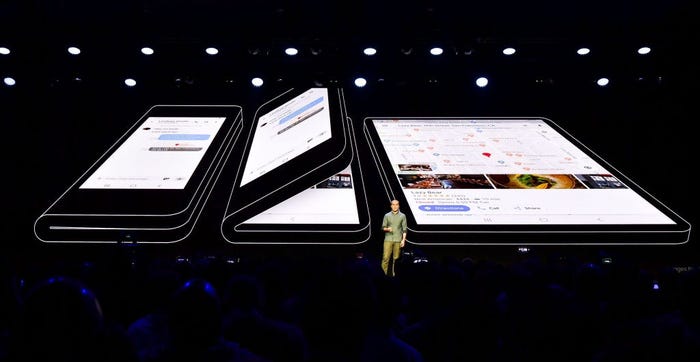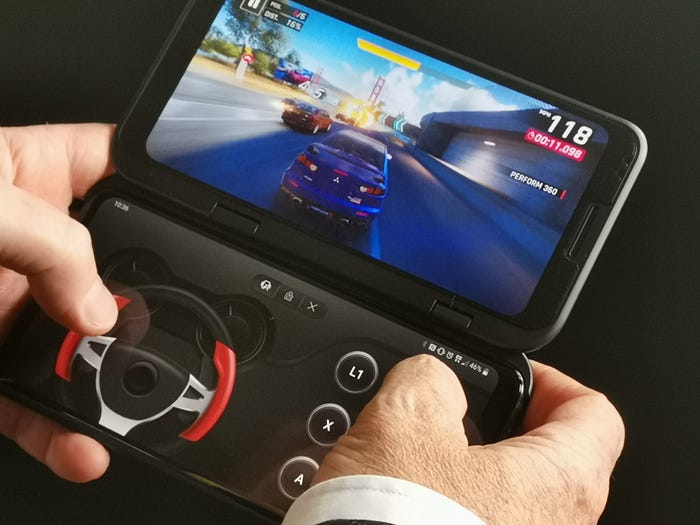Apple poised to enter the foldy-phone frayApple poised to enter the foldy-phone fray
A patent for a new foldable phone has emerged in the United States Patent and Trademark Office, signalling Apple’s entry into the desperate battle for innovation.
May 29, 2019

A patent for a new foldable phone has emerged in the United States Patent and Trademark Office, signalling Apple’s entry into the desperate battle for innovation.
Filed on March 28, the document describes an electronic device with ‘bendable or flexible layers’ to move towards creating a new form-factor for the iLeader. Although Apple has been relatively quiet in the foldable arena to date, it wasn’t going to be too long before the smartphone giant made some noise.
While this innovation might have appeared to be a flash-in-the-pan, the idea of a foldable device will keep imaginative engineers busy. The smartphone industry has been crying out for innovation for years, and while the initial introduction of foldable devices might have been a flop, there is certainly potential in the long-run.
Although the underlying theme of Mobile World Congress this year was the gradual movement towards 5G, devices always seem to wrestle some attention in the headlines. The return of Nokia devices snatched it in 2017, while a Matrix style device caught attention last year, but it was foldable devices in Barcelona this February.

Samsung was the first to start talking about the concept last summer, while Huawei certainly attempted to steal some of the thunder. However, it was Samsung who won the race at Mobile World Congress, though the devices have failed to live up to expectations. Reviewers for a host of different media titles reported faults with the devices, leading to numerous delays and recalls. The official release date was supposed to be May, before being pushed back to June, and now it seems there might be further delays with no concrete date in sight.
And while Samsung is facing engineering difficulties, Huawei’s are much more troublesome. A major disruption to its global supply chain, owed to the White House, puts the prospects of many devices in question, most notably due to Google putting its relationship with Huawei on pause.
The foldable devices segment has seemingly ground to a halt, fading from the headlines after claiming its 15 minutes of fame.
And then Apple makes its debut on the folding stage.
If we were being honest with ourselves, this was always going to be nothing more than a minor set back for foldable devices. The smartphone segment has been searching for innovation, with the last genuine disruption coming back in the noughties when Apple ditched the keyboard. A lack of buttons might have disturbed consumers at the beginning, but who would go back to that era now?
The same will be said about foldable phones. Once they enter the market, consumers will find reason to like them. Whether it is multi-taskers on the tube, gamers with more real estate to enjoy, or watching movies on a wider screen. There are usecases now, and new ones will emerge in the coming years. The devices might not intrigue everyone, but there will be a place in the technology.
It also gives smartphone manufacturers a reason to ask consumers to spend more money. Right now, consumers are being asked to spend extortionate amounts on incremental upgrades. Demand has gone down, we have seen this in the smartphone shipment figures each quarter, and the refurbished devices market is growing steadily. Consumers are sick of taking out second mortgages for much the same.
And when Apple decides to showcase its own device, you can pretty much guarantee there will be queues around the corner.
Apple is the master of creating and cultivating a brand identity and loyalty amongst its customers. Some might say the closed ecosystem is forced loyalty, but many Apple customers life and breathe the brand. There are a few faltering at the moment, you can see that through Apple’s sliding market share, but they may well be brought back by genuine innovation.
However, what is worth noting is that Apple does make excellent products. It would be unfair to credit all of its success to the marketing department; the engineers do chip in as well.
Most of the time the specs are market leading and the reviews are some of the highest around. Apple’s engineers live through a culture of perfection, dating back to the leadership of Steve Jobs, which is represented through the price of the products and the loyalty of the customers.
One of the issues which all manufacturers will face is the thickness of the phone. Smartphones are increasingly becoming sleek devices, incredibly light and not that intrusive. Foldable devices which we have seen so far certainly do not fit this description. Such is the challenge of doubling the size of the screen, and the power demands which accompany this real estate, these devices are bulky. It might turn off some consumers.
LG has come up with an interesting concept, somewhat of a halfway house, with its latest device, the V50ThinQ 5G. The smartphone can be plugged into a separate module, which includes a second screen. This product effectively has the same advantages of a foldable screen, double the screen space, but the phone can be taken out of the module for everyday use. It isn’t the full-blown promise, but it is an interesting addition.

Another minor irk for some reviewing the devices is that they are not completely flat. Even when fully extended, there is still a slight bend in the screen. This is really nit-picking, as it won’t impact experience that much, but hyper-techno-enthusiasts will pick on this minor ‘flaw’ in the devices.
Price is another consideration; can Apple create a product which is friendly enough to the wallet? Apple customers are of course used to paying a premium, but foldable devices could take this to a new extreme. Huawei’s first foldable device was priced at $2,600 while Samsung’s was $1,920. Apple is traditionally more expensive than these two, but that would surely be too much to ask of customers.
The second-wave of foldable devices are likely to be cheaper, and soon enough economics of scale in the manufacturing facilities will kick-in. But whether smartphone manufacturers are pricing themselves out of the market remains to be seen with future launches.
Finally, the durability of the devices needs to be questioned. Smartphones are already delicate pieces of kit, just look at the number of cracked screens which are being carried around today, and introducing a fold introduces another weakness for the clumsy and drunken to take advantage of.
These are a challenges Apple engineers will have to consider if it wants to woo its followers back into line.
That is not to say Apple customers blindly follow however. Not only have you got some switching to more price-friendly alternatives, you have to remember how long it took the Apple Watch product line to gain traction. Even now some might say this is a product line which is struggling to live up to the promise.
But Apple is Apple…
If anyone can crack the foldable devices market, Apple would certainly be a sensible bet.
About the Author
You May Also Like










.png?width=300&auto=webp&quality=80&disable=upscale)


_1.jpg?width=300&auto=webp&quality=80&disable=upscale)